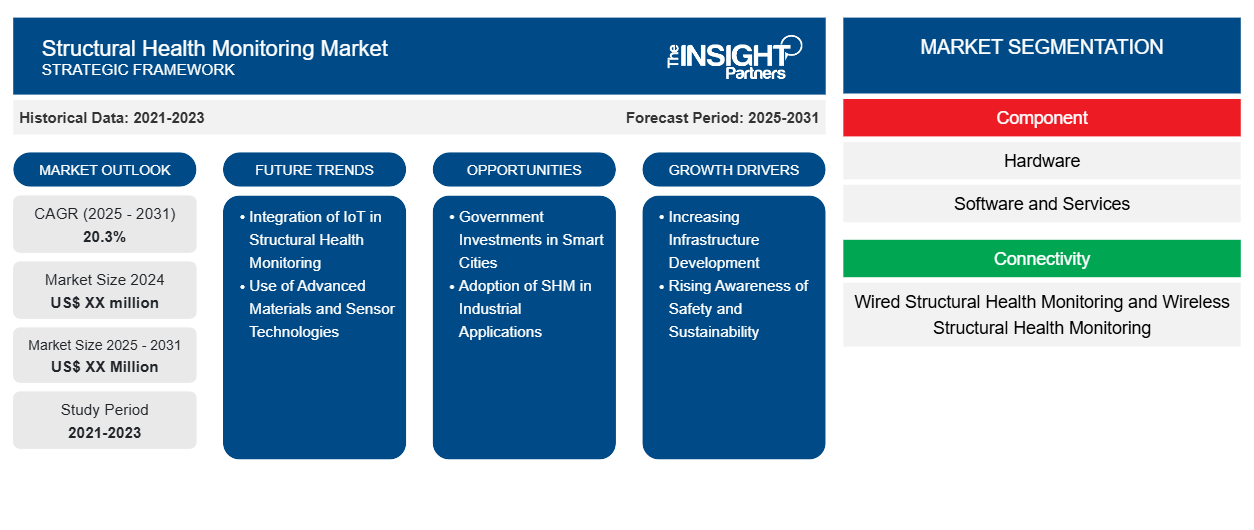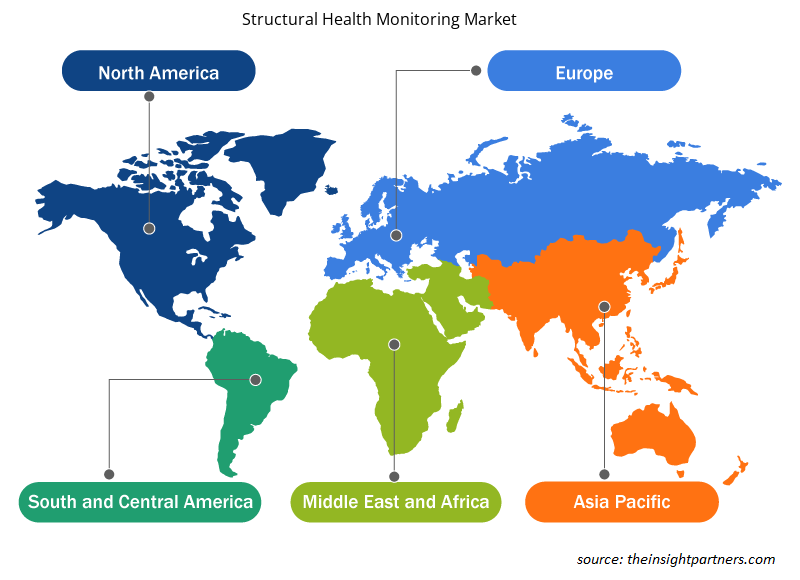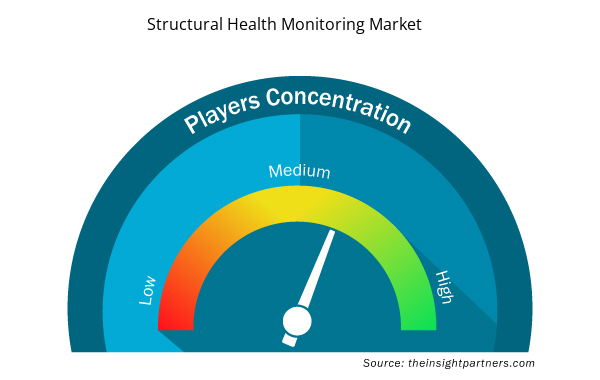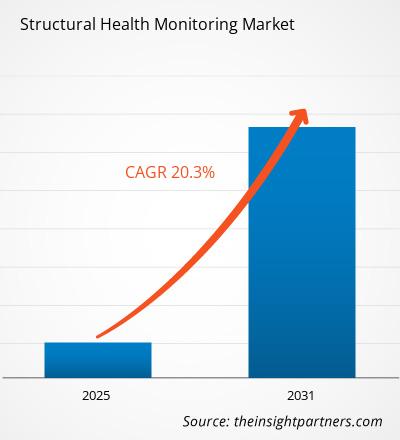The Structural Health Monitoring Market is expected to register a CAGR of 20.3% from 2025 to 2031, with a market size expanding from US$ XX million in 2024 to US$ XX Million by 2031.
The report is segmented by Component (Hardware, Software and Services); Connectivity (Wired Structural Health Monitoring and Wireless Structural Health Monitoring); End-User (Oil and Gas, Civil Infrastructure, Aerospace and Defense, Energy, Mining, and Others). The global analysis is further broken-down at regional level and major countries. The report offers the value in USD for the above analysis and segments
Purpose of the Report
The report Structural Health Monitoring Market by The Insight Partners aims to describe the present landscape and future growth, top driving factors, challenges, and opportunities. This will provide insights to various business stakeholders, such as:
- Technology Providers/Manufacturers: To understand the evolving market dynamics and know the potential growth opportunities, enabling them to make informed strategic decisions.
- Investors: To conduct a comprehensive trend analysis regarding the market growth rate, market financial projections, and opportunities that exist across the value chain.
- Regulatory bodies: To regulate policies and police activities in the market with the aim of minimizing abuse, preserving investor trust and confidence, and upholding the integrity and stability of the market.
Structural Health Monitoring Market Segmentation
Component
- Hardware
- Software and Services
Connectivity
- Wired Structural Health Monitoring and Wireless Structural Health Monitoring
End-User
- Oil and Gas
- Civil Infrastructure
- Aerospace and Defense
- Energy
- Mining
- Others
Geography
- North America
- Europe
- Asia-Pacific
- South and Central America
- Middle East and Africa
Customize This Report To Suit Your Requirement
You will get customization on any report - free of charge - including parts of this report, or country-level analysis, Excel Data pack, as well as avail great offers and discounts for start-ups & universities
Structural Health Monitoring Market: Strategic Insights

- Get Top Key Market Trends of this report.This FREE sample will include data analysis, ranging from market trends to estimates and forecasts.
Structural Health Monitoring Market Growth Drivers
- Increasing Infrastructure Development: The ongoing growth in infrastructure projects worldwide, such as bridges, buildings, and highways, is driving the demand for structural health monitoring (SHM) systems. These systems help ensure the safety, durability, and longevity of these structures, minimizing maintenance costs and preventing failures.
- Rising Awareness of Safety and Sustainability: Growing awareness about the importance of safety, environmental sustainability, and asset management is fueling the adoption of SHM systems. These technologies help detect structural issues early, ensuring timely repairs and reducing the environmental impact of infrastructure degradation.
Structural Health Monitoring Market Future Trends
- Integration of IoT in Structural Health Monitoring: The integration of Internet of Things (IoT) technologies is revolutionizing SHM. IoT-enabled sensors provide real-time data on the condition of structures, improving monitoring efficiency and accuracy. This trend is leading to more automated, cost-effective, and scalable SHM solutions across various industries.
- Use of Advanced Materials and Sensor Technologies: Advancements in sensor technologies and materials, such as fiber optic sensors and carbon nanotubes, are improving the capabilities of SHM systems. These innovations allow for more accurate, reliable, and long-lasting monitoring of structural integrity, expanding SHM applications in critical infrastructure such as dams, high-rise buildings, and offshore platforms.
Structural Health Monitoring Market Opportunities
- Government Investments in Smart Cities: The push for smart city initiatives offers significant opportunities for SHM solutions. Governments are investing in intelligent infrastructure with integrated monitoring systems to improve urban resilience, leading to an increased demand for advanced SHM technologies in cities worldwide.
- Adoption of SHM in Industrial Applications: Industries such as oil and gas, aerospace, and energy are adopting SHM systems to monitor the integrity of critical assets. As industries seek to reduce downtime and maintenance costs, the demand for SHM solutions in industrial applications is expected to rise substantially.
Structural Health Monitoring Market Regional Insights
The regional trends and factors influencing the Structural Health Monitoring Market throughout the forecast period have been thoroughly explained by the analysts at Insight Partners. This section also discusses Structural Health Monitoring Market segments and geography across North America, Europe, Asia Pacific, Middle East and Africa, and South and Central America.

- Get the Regional Specific Data for Structural Health Monitoring Market
Structural Health Monitoring Market Report Scope
| Report Attribute | Details |
|---|---|
| Market size in 2024 | US$ XX million |
| Market Size by 2031 | US$ XX Million |
| Global CAGR (2025 - 2031) | 20.3% |
| Historical Data | 2021-2023 |
| Forecast period | 2025-2031 |
| Segments Covered |
By Component
|
| Regions and Countries Covered | North America
|
| Market leaders and key company profiles |
Structural Health Monitoring Market Players Density: Understanding Its Impact on Business Dynamics
The Structural Health Monitoring Market market is growing rapidly, driven by increasing end-user demand due to factors such as evolving consumer preferences, technological advancements, and greater awareness of the product's benefits. As demand rises, businesses are expanding their offerings, innovating to meet consumer needs, and capitalizing on emerging trends, which further fuels market growth.
Market players density refers to the distribution of firms or companies operating within a particular market or industry. It indicates how many competitors (market players) are present in a given market space relative to its size or total market value.
Major Companies operating in the Structural Health Monitoring Market are:
- Acellent Technologies, Inc.
- Campbell Scientific, Inc.
- Digitex
- Geocomp Corporation
- HBM
Disclaimer: The companies listed above are not ranked in any particular order.

- Get the Structural Health Monitoring Market top key players overview
Key Selling Points
- Comprehensive Coverage: The report comprehensively covers the analysis of products, services, types, and end users of the Structural Health Monitoring Market, providing a holistic landscape.
- Expert Analysis: The report is compiled based on the in-depth understanding of industry experts and analysts.
- Up-to-date Information: The report assures business relevance due to its coverage of recent information and data trends.
- Customization Options: This report can be customized to cater to specific client requirements and suit the business strategies aptly.
The research report on the Structural Health Monitoring Market can, therefore, help spearhead the trail of decoding and understanding the industry scenario and growth prospects. Although there can be a few valid concerns, the overall benefits of this report tend to outweigh the disadvantages.
- Historical Analysis (2 Years), Base Year, Forecast (7 Years) with CAGR
- PEST and SWOT Analysis
- Market Size Value / Volume - Global, Regional, Country
- Industry and Competitive Landscape
- Excel Dataset



Report Coverage
Revenue forecast, Company Analysis, Industry landscape, Growth factors, and Trends

Segment Covered
Component, Connectivity, End-User, and Geography

Regional Scope
North America, Europe, Asia Pacific, Middle East & Africa, South & Central America

Country Scope
US, UK, Canada, Germany, France, Italy, Australia, Russia, China, Japan, South Korea, Saudi Arabia, Brazil, Argentina
Frequently Asked Questions
Some of the customization options available based on the request are an additional 3-5 company profiles and country-specific analysis of 3-5 countries of your choice. Customizations are to be requested/discussed before making final order confirmation# as our team would review the same and check the feasibility
The report can be delivered in PDF/PPT format; we can also share excel dataset based on the request
Integration of IoT in structural health monitoring is anticipated to play a significant role in the global Structural health monitoring market in the coming years.
Increasing infrastructure development and rising awareness of safety and sustainability are the major factors driving the Structural health monitoring market.
The Structural Health Monitoring Market is estimated to witness a CAGR of 20.3% from 2023 to 2031
Trends and growth analysis reports related to Electronics and Semiconductor : READ MORE..
The List of Companies
1. Acellent Technologies, Inc.
2. Campbell Scientific, Inc.
3. Digitex
4. Geocomp Corporation
5. HBM
6. James Fisher and Sons plc
7. Kinemetrics, Inc.
8. Nova Metrix LLC (Nova Ventures Group Corp.)
9. Resensys, LLC
10. SIXENSE Systems

 Get Free Sample For
Get Free Sample For